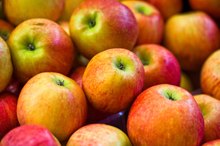Glycemic Index of Cheerios
The glycemic index, or GI, classifies carbohydrate foods according to the extent to which they increase blood sugar levels after eating 1. The foods are listed on a scale of zero to 100, with zero being the foods that have are digested slowly, resulting in gradual rises in blood sugar levels, and 100 being foods that are rapidly digested, resulting in rapid spikes in blood sugar levels. People with diabetes may follow low glycemic index diets to help regulate blood sugar levels.
How the Glycemic Index is Measured
The GI is measured by serving 10 or more people a sample of a particular carbohydrate food. In this case, the food is Cheerios. A serving of the food that contains 50 g of carbohydrate is given to the panel of testers, and then the effect on their blood sugar is measured at regular intervals with simple blood tests. These results are compared with the blood test results after the same people consume a 50-g sample of glucose.
- The GI is measured by serving 10 or more people a sample of a particular carbohydrate food.
- A serving of the food that contains 50 g of carbohydrate is given to the panel of testers, and then the effect on their blood sugar is measured at regular intervals with simple blood tests.
Using Glycemic Index Results
The Glycemic Index of Green Peas
Learn More
Foods with a GI of 55 or less are considered low. Conversely, foods with a GI of 70 or more are considered high. The Glycemic Index Foundation recommends that people eat foods low on the GI more often 1. The proposed health benefits of doing this are more sustained energy levels, lowered insulin secretion, decreased body weight, lowered LDL cholesterol and triglyceride levels, and improved skin.
- Foods with a GI of 55 or less are considered low.
- The Glycemic Index Foundation recommends that people eat foods low on the GI more often 1.
Cheerios
Cheerios have a GI of 74, which puts the cereal on the higher end of the scale. Cheerios are widely recognized as being a heart healthy source of dietary fiber, but it may not be the best choice for someone looking to eat a low GI diet.
A Low Glycemic Index Alternative
Can I Tell What the Glycemic Index Is by Reading a Food Label?
Learn More
If Cheerios are not a good choice for you because they are too high on the GI, try a bran cereal. A bran breakfast cereal is a whole grain cereal that rich in dietary fiber, with a GI of only 30. If you're willing to branch out even further than breakfast cereal in the morning, a banana smoothie is low on the GI, as are certain fruits.
Related Articles
References
- Glycemic Index GI Database: Cheerios
- Ojo O, Ojo OO, Adebowale F, Wang XH. The effect of dietary glycaemic index on glycaemia in patients with type 2 diabetes: A systematic review and meta-analysis of randomized controlled trials. Nutrients. 2018;10(3):373. Published 2018 Mar 19. doi:10.3390/nu10030373
- Glycemic Index and Diabetes. American Diabetes Association
- Search for the Glycemic Index. The University of Sydney
- Zeevi D, Korem T, Zmora N, et al. Personalized Nutrition by Prediction of Glycemic Responses. Cell. 2015;163(5):1079-1094. doi:10.1016/j.cell.2015.11.001+
- Sacks FM, Carey VJ, Anderson CA, et al. Effects of high vs low glycemic index of dietary carbohydrate on cardiovascular disease risk factors and insulin sensitivity: the OmniCarb randomized clinical trial. JAMA. 2014;312(23):2531-41. doi:10.1001/jama.2014.16658.
- Vega-lópez S, Venn BJ, Slavin JL. Relevance of the Glycemic Index and Glycemic Load for Body Weight, Diabetes, and Cardiovascular Disease. Nutrients. 2018;10(10). doi:10.3390/nu10101361
- Glycemic Index Database. University of Sydney. Updated October 13, 2020
- Eleazu C. O. (2016). The concept of low glycemic index and glycemic load foods as panacea for type 2 diabetes mellitus; prospects, challenges and solutions. African health sciences, 16(2), 468–479. doi:10.4314/ahs.v16i2.15
- Foster-Powell, Kaye, Holt, Susanna and Brand-Miller, Janette. "International table of glycemic index and glycemic load values: 2002." American Journal of Clinical Nutrition. 76,:1: 5-56 (2002).
- International Carbohydrate Quality Consortium, Jenkins, D. J., Willett, W. C., Astrup, A., Augustin, L. S., Baer-Sinnott, S., … Wolever, T. M. (2014). Glycaemic index: did Health Canada get it wrong? Position from the International Carbohydrate Quality Consortium (ICQC). The British journal of nutrition, 111(2), 380–382. doi:10.1017/S0007114513003905
- Leroux, MarcusFoster-Powell, Kaye, Holt, Susanna and Brand-Miller, Janette. "International Table of Glycemic Index and Glycemic Load Values: 2002." American Journal of Clinical Nutrition. Vol. 76, No. 1, 5-56, (2002).
- Lui, S., Willett, WC, et al. "A prospective study of dietary glycemic load, carbohydrate intake, and risk of coronary heart disease in US women.." American Journal of Clinical Nutrition. 71(6):1455-61. (2001).
- Mayer-Davis, E.J., Dhawan, A et al. "Towards understanding of glycaemic index and glycaemic load in habitual diet: associations with measures of glycaemia in the Insulin Resistance Atherosclerosis Study.." British Nutrition Journal. 95(2):397-405. (2006).
- Sacks, F. M., Carey, V. J., Anderson, C. A., Miller, E. R., 3rd, Copeland, T., Charleston, J., … Appel, L. J. (2014). Effects of high vs low glycemic index of dietary carbohydrate on cardiovascular disease risk factors and insulin sensitivity: the OmniCarb randomized clinical trial. JAMA, 312(23), 2531–2541. doi:10.1001/jama.2014.16658
- Salmeron, J, Manson, JE, et al. "Dietary fiber, glycemic load, and risk of non-insulin-dependent diabetes mellitus in women.." Journal of the American Medical Association. 12;277(6):472-7. (1997).
- Vega-López, S., Venn, B., & Slavin, J. (2018). Relevance of the Glycemic Index and Glycemic Load for Body Weight, Diabetes, and Cardiovascular Disease. Nutrients, 10(10), 1361. doi:10.3390/nu10101361
- Zeevi, D. Korem N. et al. Personalized Nutrition by Prediction of Glycemic ResponsesCell. 163:(5):1079-94. November 2015.
Resources
Writer Bio
Kelly Slattery is a registered dietitian who has been employed in the hospital setting since 2003. Slattery has written several articles published in local publications such as hospital and community newsletters. She obtained her bachelor's degree in nutrition in 2002 and is currently working towards a master's degree in health care administration.









